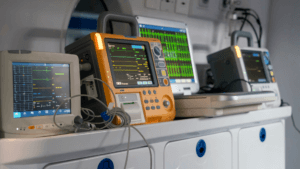Medical Technology
Medical Membrane Switches & Touchscreens
Medical membrane switches and medical device touchscreen technologies have become widespread throughout hospitals, clinics, and other healthcare environments. Critical medical devices rely on these electronic control panels to function as designed within the healthcare industry.
Dyna-Graphics is a leading medical and health device manufacturer of medical touchscreens, membrane switches and rubber keypads. Perfect for fast-paced environments where every second counts, medical touchscreens and membrane switches are designed for quick, easy, and accurate operation.

Medical HMI Devices
Transforming Healthcare with HMI Devices and Systems for Streamlined Care
Human Machine Interface (HMI) systems provide controls that enable users to operate a medical device, machine, or instrument. Well-designed HMI systems allow medical and healthcare professionals to quickly and reliably access the critical devices needed to treat patients and perform functions with straightforward communication capabilities. Poor HMI system designs can result in unwanted consequences, including longer wait times, higher operational costs, lapses in communication, and health ramifications for patients requiring care.
Membrane Switches for Medical Devices
Medical membrane switches offer customization opportunities to enable medical device manufacturers to develop appropriate interfaces that provide an enhanced medical HMI experience. A typical membrane switch assembly contains several layers, all serving a distinct purpose for the entire medical membrane switch. These layers can include:
- Graphic overlay
- Overlay adhesive
- Top circuit layer
- Circuit spacer
- Lower circuit layer
- Rear adhesive layer
- Rigid support layer
Design Considerations
Medical membrane switches allow for numerous design options that are honed to your specific medical application. Some of the additional features that we can customize to your exact specifications include, but are not limited to:
- Embossing
- Circuit encoding
- Hard coat finishes
- Tactile response
- Filter windows
- Backlighting
- Panel interconnections
- Subpanels
- Elastomer keypads
Benefits
Medical device membrane switches and keypads are well-suited for medical electronics. These medical HMI technologies are limited to a specific or small number of functions, are portable, and require a high degree of visibility. Membrane switches are particularly suitable for handheld medical applications and portable devices because they are lightweight, low profile, durable, easy to clean, RoHS compliant, and contain other key attributes:
Cleanliness. New antimicrobial film technologies are now being used for membrane switch applications to ensure medical-grade cleanliness. This antimicrobial technology disrupts the bacterial cell wall, killing or inhibiting bacterial growth. The film surface of the membrane switch provides dependable and constant protection against bacterial contamination.
Shielding. Membrane switches protect against electrostatic discharge (ESD) within medical HMI systems. An inner layer of the switch assembly can take such discharges to ground. Printed shield layers can be tailored to each unique application, providing optimal shielding effects and preventing unwanted intrusion from incoming or outgoing signals. Shielding can generally be accomplished without conceding the performance or quality of the medical device switch or medical HMI assembly.
Graphics. Medical device membrane switches provide product enhancement and differentiation. With an essentially unlimited color palette, the graphic overlay provides aesthetically pleasing yet highly useful characteristics to the medical device. Simple color and artwork modifications provide low-cost models or functional variations. Lower switch layers remain constant, keeping total program costs down.
Ability to Seal. As a direct medical device membrane switch manufacturer, our membrane keypads and switches can be sealed against various surroundings or contamination risks typically encountered in the portable medical device and healthcare industries. This can be achieved with a full perimeter seal or routing the circuit tail exit within a gasket.
Lighting. There are two ways to effectively illuminate a medical device membrane switch: LEDs and electroluminescent panels. LEDs communicate device status near or at a distance. Electroluminescent lamps are not interchangeable with LEDs but work well for backlighting in low-light situations.
Touchscreens for Medical Devices & Medical HMI Systems
Medical device touchscreens generate solutions for a variety of healthcare electronic interface issues. They offer simplicity by reducing peripheral devices, such as a mouse or keyboard, and eliminating external components like buttons, switches, and dials.

Resistive Medical Device Touchscreens
Resistive medical device touchscreens are very thin and constructed in several different layers of material with a small air gap between each layer. The resistive touchscreen can then be manipulated with any pointy object, making it ideal for health applications in harsher environments such as an ambulance where the operator usually wears gloves. Applications include:
- Portable diagnostic equipment
- Clinic operations in rural or undeveloped environments
- Mobile military clinics
- And many more
Resistive overlays are the lowest cost option and require minimal programming to integrate with an LCD module.
Capacitive Medical Device Touchscreens
This type of medical touchscreen panel contains an insulating material like glass coated with a transparent conducting material such as indium tin oxide (ITO). The human body acts as an electrical conductor, interrupting the electrostatic field when a finger encounters the surface of the glass. The panel is then able to locate the position of the contact. This medical touchscreen technology allows for movements such as swiping and pinching. This type of medical HMI technology eliminates the need for the user to move from patient to keyboard, mouse, or touchscreen and back to the patient. Possible applications include:
- Operating room procedures
- Reviewing medical images
- Touchless operating table tasks
- Outdoor medical necessities
- And more
Capacitive touchscreens are more expensive to manufacture than resistive touchscreens, but the enhanced performance capabilities within health or medical device applications are worth the additional cost.
Your Certified Quality Medical Device Interface Manufacturer
Request a quote on medical membrane switches and medical device touchscreens, or any of our HMI solutions.
Or contact Dyna-Graphics to discuss your custom requirements or to learn more.
